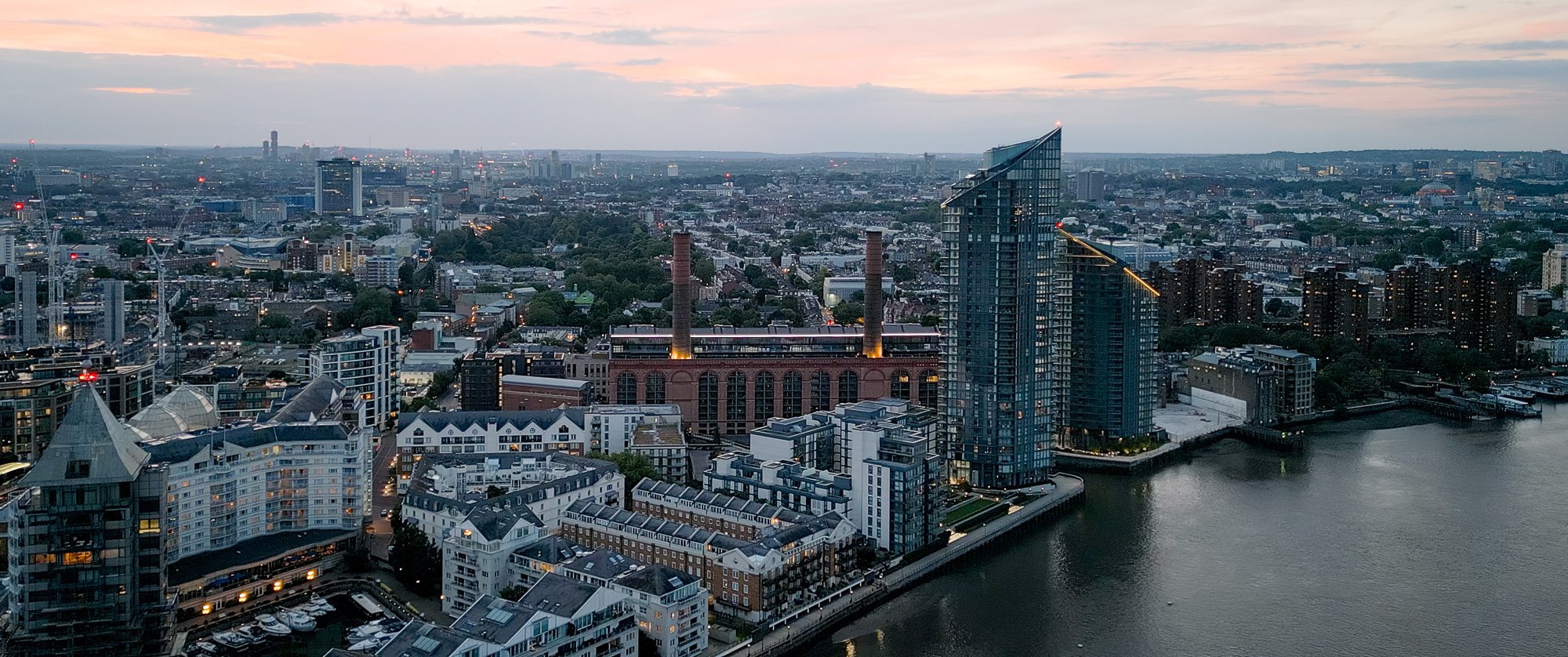The lOts road power station
Chelsea Waterfront
pOwerhouse Chelsea
Lots Road Power Station: A Historic Landmark's Evolution and Future Development
Historic Beginnings
Lots Road Power Station
The Lots Road Power Station stands as a monumental testament to the city's industrial prowess. Commissioned in the early 20th century, this iconic building was initially constructed to power the burgeoning London Underground network. Designed by the eminent US engineer James Russell Chapman, the power station began its operations in 1905, pre-dating Battersea Power Station by 39 years. It effectively transformed the dynamics of urban transportation in London by providing power to the underground system. Construction started in 1902, it was completed in December 1904, with the Power Station opening the following February. Lots Road was claimed to be the largest power station ever built, measuring 453ft x 275ft at the time of construction. Coal was supplied by barge from a specially-constructed tidal basin at Chelsea Creek, and from the adjacent West London Railway.
Industrial Marvel
When it was built, the Lots Road Power Station was heralded as the largest power station of its kind. Its construction involved the use of over 700 tonnes of coal daily, a testament to its formidable capacity. The architectural style, blending Romanesque and Gothic Revival elements, coupled with its towering chimneys, made it a striking addition to the London skyline. The station's vast halls, filled with the hum of generators and the sight of manual controls, evoked a sense of industrial grandeur.
Powering London Transport
For nearly a century, the power station played a pivotal role in powering London's transport systems. It was the central power station for the London Underground, ensuring the seamless operation of the city's underground railway. The station's significance extended beyond transportation, as it also became a birthplace for commercial radio in the UK, temporarily hosting two radio stations, LBC and Capitol Radio, until 1975.
Transformation and Decline
Modernisation and Closure
The mid-20th century saw significant changes at Lots Road. The power station underwent a series of modernisations, including a switch from coal to heavy fuel oil and later to efficient fuel sources like natural gas. The original four 275 foot tall chimney stacks above the boiler house became 3 in the 1960s and two in the ’70s, when for a period it ran on gas, owing to rocketing oil prices. Despite these upgrades, the station's operations ceased in 2002, marking the end of an era. The closure of the station was attributed to the high costs of operation and the shift towards more sustainable energy sources.
Preservation Efforts
Following its closure, the Lots Road Power Station faced the threat of demolition. However, its historical significance and architectural beauty spurred efforts to preserve this iconic building. Preservationists and enthusiasts rallied to protect the station, recognising its value as a tangible link to London's industrial past. In 1999, London Transport sold the power station site to Circadian for £34 million who planned to convert the power station into shops, restaurants, and apartments, as well as construct additional buildings, including two skyscrapers, on the adjacent vacant land.
A New Dawn: Chelsea Waterfront Development
Visionary Redevelopment
In the early 21st century, a visionary redevelopment plan was conceived to breathe new life into the disused coal-fired power station. The Hutchison Property Group, in collaboration with renowned architect Terry Farrell, embarked on an ambitious project to transform Lots Road into a world-class residential and commercial hub. The project, known as Chelsea Waterfront, promised to blend the site's historical features with contemporary luxury.
Architectural Design
The redevelopment of Lots Road Power Station into Chelsea Waterfront is a masterclass in architectural design. The project preserves the original structure of the power station, including its distinctive brick walls and towering chimneys, while introducing modern elements like glass residential towers. The residential buildings, designed by Formation Architects, feature luxurious apartments with private balconies offering captivating river views.
Sustainable Development
Sustainability is at the heart of the Chelsea Waterfront development. The integration of eco-friendly technologies ensures a reduced carbon footprint, aligning with modern environmental standards. The development also includes beautifully-lit landscaped gardens and water features, designed by world-renowned landscape architects Randle Siddeley, creating a serene and picturesque environment for residents.
New Amenities and residential units
Luxury Apartments
The Lots Road Power Station has been transformed into an exquisite collection of luxury apartments. The residential tower, known as Powerhouse Chelsea, offers a range of apartment sizes, from cosy one-bedroom units to expansive four-bedroom penthouses. Each unit is meticulously designed to blend historical charm with modern elegance, providing residents with an unparalleled living experience.
State-of-the-Art Facilities
Residents of Powerhouse Chelsea have access to an array of world-class amenities. The development boasts a 20-metre swimming pool, a health and fitness centre, and a luxurious spa. A 24-hour concierge service ensures convenience and security, while the Club Lounge offers a sophisticated space for socialising and relaxation.
Commercial and Recreational Spaces
Beyond residential units, Chelsea Waterfront features a variety of commercial and recreational spaces. The development includes high-end restaurants, boutique shops, and a health and fitness club. The landscaped atrium and adjacent gardens provide residents with ample green spaces to enjoy leisurely strolls along the riverbank.
The Neighbourhood: Chelsea's vibrant Atmosphere
Chelsea Design Quarter
Situated in the heart of the Chelsea Design Quarter, Lots Road Power Station enjoys proximity to a vibrant hub of creativity and innovation. The area is renowned for its influential boutiques, luxury concept stores, and design studios, making it a magnet for interior designers and art enthusiasts.
Design Centre Chelsea Harbour
Just a stone's throw away from Lots Road is the Design Centre Chelsea Harbour, a premier destination for high-end interior design. This state-of-the-art facility houses an array of showrooms and galleries, offering a diverse selection of design inspirations and products.
Cremorne Gardens
Established in the mid-19th century as a public pleasure garden, Cremorne Gardens was designed to provide Londoners with a place of leisure and amusement. The gardens quickly gained fame for their lively atmosphere, featuring a plethora of attractions including concerts, theatrical performances, firework displays, and even hot air balloon ascents, which were a marvel of the era. Cremorne Gardens was known for drinking, dancing, tightrope walks across the Thames, parachuting monkeys, and its infamous association with the West End's demi-monde. This led to its downfall in 1877 when it was branded a "nursery of every kind of vice."
Lots Road Pub
The Lots Road Pub, a beloved Chelsea institution, boasts a rich history that mirrors the evolution of the neighbourhood itself. Originally known as "The Balloon," this early 20th-century establishment served the workers of the nearby Lots Road Power Station. The name "The Balloon" harkens back to the era of ballooning, a popular and daring sport at the time, symbolising adventure and the innovative spirit of the industrial age. Over the decades, the pub evolved alongside its surroundings, at one stage being named the Ferret and Firkin in the Balloon Up the Creek, and later adopting the name Lots Road Pub to reflect its deep-rooted connection to the local community.
Historical Significance and Modern Elegance
Preserving the Past
The redevelopment of Lots Road Power Station is a celebration of London's rich industrial heritage. The project meticulously preserves the original features of the power station, including its historic structure and brick walls. This careful preservation effort ensures that the building's historical significance is retained, even as it is repurposed for contemporary use.
Integrating Modern Elements
While honouring its past, the Chelsea Waterfront development seamlessly integrates modern elements to create a luxurious living environment. The glass residential towers and state-of-the-art amenities embody the best of 21st-century high-end living spaces, offering residents a blend of comfort, style, and convenience.
Iconic Building
The transformed Lots Road Power Station stands as an iconic building on the Chelsea Riverfront. Its twin-turreted power house, preserved and modernised, serves as a beacon of the area's evolution from an industrial hub to a centre of luxury and sophistication.
Contemporary uses and Future prospects
Residential Complex
The primary contemporary use of the Lots Road Power Station is as a residential complex. The Powerhouse Chelsea offers 260 luxury apartments, providing a unique living experience that combines historical charm with modern amenities. The development is set to attract discerning buyers from around the world, including those seeking an investment property in one of London's most prestigious neighbourhoods.
Commercial Opportunities
In addition to residential units, the Chelsea Waterfront development includes a range of commercial opportunities. The presence of boutique shops, high-end restaurants, and recreational facilities enhances the appeal of the area, making it a vibrant community hub.
Cultural and Recreational Hub
The redeveloped Lots Road Power Station is poised to become a cultural and recreational hub in Central London. With its mix of residential, commercial, and recreational spaces, the development offers a dynamic environment where art, culture, and community converge.
Community Engagement and Local Impact
Involving the Community
The success of the Chelsea Waterfront development is rooted in community engagement. The project has involved local residents and stakeholders in the planning process, ensuring that the development meets the needs and aspirations of the community. This collaborative approach has helped to build a sense of ownership and pride among residents.
Economic Boost
The redevelopment of Lots Road Power Station has provided a significant economic boost to the area. The creation of new jobs, both during the construction phase and in the ongoing operation of the commercial spaces, has contributed to the local economy. Additionally, the influx of residents and visitors has spurred growth in local businesses.
Preserving Local Heritage
The preservation of Lots Road Power Station is not just about maintaining a historical structure; it is also about preserving the local heritage and identity. The development pays homage to the area's industrial past while paving the way for a vibrant future.
The powerhouse Interiors
The transformation of Lots Road Power Station into Chelsea Waterfront is a masterful blend of historical preservation and modern innovation. The project stands as a testament to the vision and expertise of the developers, architects, and community members who have worked together to create a world-class development.
Bespoke Pieces by Fiona Barratt Interiors
Fiona Barratt Interiors brings exquisite craftsmanship to Powerhouse Chelsea with bespoke furniture pieces that blend contemporary design with traditional techniques. Signature designs for the public areas include sophisticated sofas, elegant tables, and beautifully crafted cabinetry. These pieces harmoniously integrate with the historical features of the Lots Road Power Station, adding a touch of refined luxury to the apartments. The Powerhouse Chelsea also features a striking lighting installation designed by Fiona Barratt that mirrors the iconic chimneys of the historic Lots Road Power Station. This large-scale lighting design pays homage to the building's industrial heritage, creating a dramatic visual effect that seamlessly integrates with the architectural elements of the redevelopment.
Show Apartments by Morpheus
The show apartment at Powerhouse Chelsea, a three bedroom lateral apartment designed by Morpheus, exemplifies luxurious living with a mix of contemporary elegance and historical charm. These apartments feature high-quality materials, custom-made furnishings, and state-of-the-art appliances. Morpheus’s attention to detail highlights the unique architectural features of the power station, creating stylish and inviting spaces. The show apartments offer inspiration for personalising and designing elegant living environments.
Future Prospects
As the Lots Road Power Station embarks on this new chapter, it promises to become a landmark in London's urban landscape. The development is set to attract residents, investors, and visitors from around the globe, drawn by its unique combination of historical charm and contemporary luxury.
A Beacon of Inspiration
Ultimately, the revitalisation of Lots Road Power Station is a beacon of inspiration. It demonstrates that even the most iconic industrial buildings can be repurposed and rejuvenated to meet the needs of the 21st century, creating spaces that honour the past while embracing the future.





























